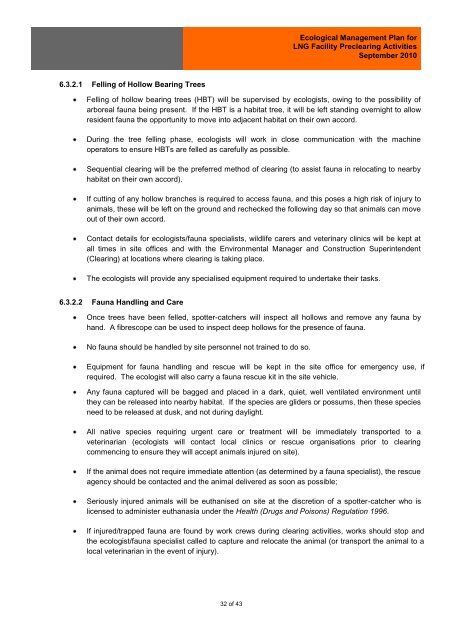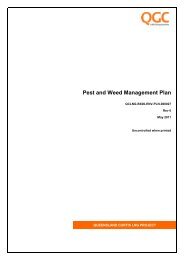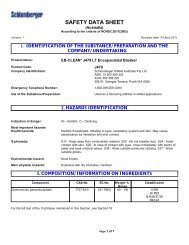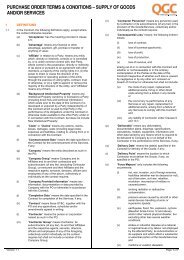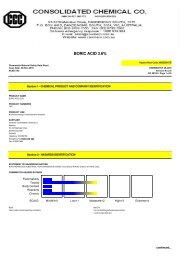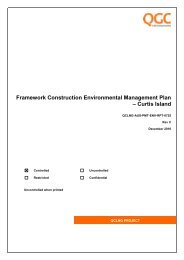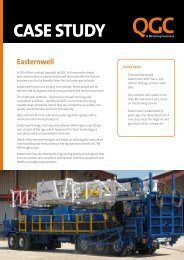Ecological Management Plan for LNG Facility Preclearing ... - QGC
Ecological Management Plan for LNG Facility Preclearing ... - QGC
Ecological Management Plan for LNG Facility Preclearing ... - QGC
You also want an ePaper? Increase the reach of your titles
YUMPU automatically turns print PDFs into web optimized ePapers that Google loves.
<strong>Ecological</strong> <strong>Management</strong> <strong>Plan</strong> <strong>for</strong><br />
<strong>LNG</strong> <strong>Facility</strong> <strong>Preclearing</strong> Activities<br />
September 2010<br />
6.3.2.1 Felling of Hollow Bearing Trees<br />
Felling of hollow bearing trees (HBT) will be supervised by ecologists, owing to the possibility of<br />
arboreal fauna being present. If the HBT is a habitat tree, it will be left standing overnight to allow<br />
resident fauna the opportunity to move into adjacent habitat on their own accord.<br />
During the tree felling phase, ecologists will work in close communication with the machine<br />
operators to ensure HBTs are felled as carefully as possible.<br />
Sequential clearing will be the preferred method of clearing (to assist fauna in relocating to nearby<br />
habitat on their own accord).<br />
If cutting of any hollow branches is required to access fauna, and this poses a high risk of injury to<br />
animals, these will be left on the ground and rechecked the following day so that animals can move<br />
out of their own accord.<br />
Contact details <strong>for</strong> ecologists/fauna specialists, wildlife carers and veterinary clinics will be kept at<br />
all times in site offices and with the Environmental Manager and Construction Superintendent<br />
(Clearing) at locations where clearing is taking place.<br />
The ecologists will provide any specialised equipment required to undertake their tasks.<br />
6.3.2.2 Fauna Handling and Care<br />
Once trees have been felled, spotter-catchers will inspect all hollows and remove any fauna by<br />
hand. A fibrescope can be used to inspect deep hollows <strong>for</strong> the presence of fauna.<br />
No fauna should be handled by site personnel not trained to do so.<br />
Equipment <strong>for</strong> fauna handling and rescue will be kept in the site office <strong>for</strong> emergency use, if<br />
required. The ecologist will also carry a fauna rescue kit in the site vehicle.<br />
Any fauna captured will be bagged and placed in a dark, quiet, well ventilated environment until<br />
they can be released into nearby habitat. If the species are gliders or possums, then these species<br />
need to be released at dusk, and not during daylight.<br />
All native species requiring urgent care or treatment will be immediately transported to a<br />
veterinarian (ecologists will contact local clinics or rescue organisations prior to clearing<br />
commencing to ensure they will accept animals injured on site).<br />
If the animal does not require immediate attention (as determined by a fauna specialist), the rescue<br />
agency should be contacted and the animal delivered as soon as possible;<br />
Seriously injured animals will be euthanised on site at the discretion of a spotter-catcher who is<br />
licensed to administer euthanasia under the Health (Drugs and Poisons) Regulation 1996.<br />
If injured/trapped fauna are found by work crews during clearing activities, works should stop and<br />
the ecologist/fauna specialist called to capture and relocate the animal (or transport the animal to a<br />
local veterinarian in the event of injury).<br />
32 of 43


